Start your fragrance making journey safely by ensuring proper ventilation and a clutter-free workspace. Always wear protective gear like chemical-resistant gloves and safety goggles. Use precise digital scales and heat-resistant containers for accurate measurements. Begin with 1:1 ratio test batches of 2-5mL, and document every blend. Conduct patch tests at 1-2% dilution, monitor for 48 hours, and prevent cross-contamination with dedicated tools. These foundational steps open the door to mastering safe oil blending techniques.
Proper Ventilation and Workspace Setup
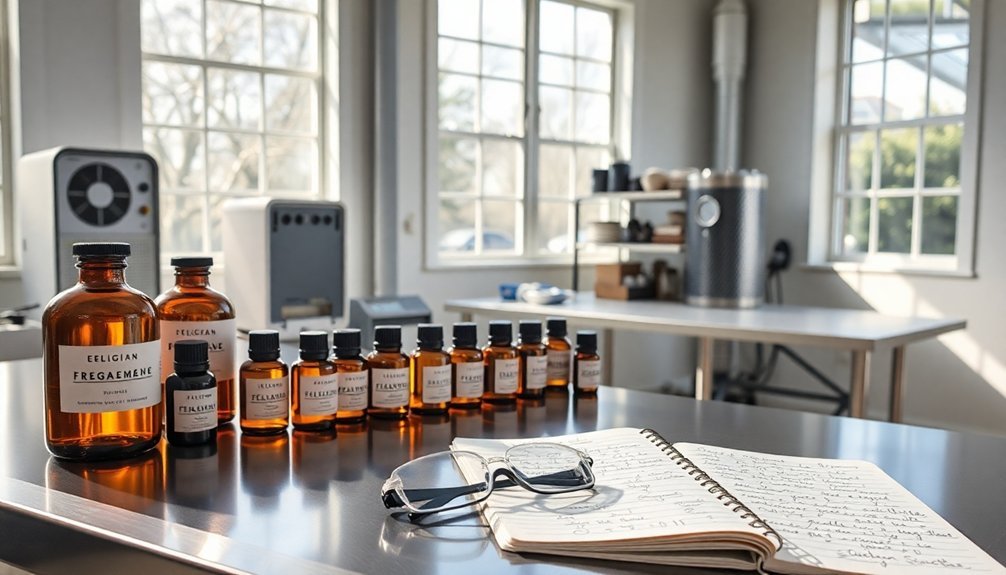
When creating your own fragrances, a properly ventilated and organized workspace is essential for both safety and success. Before beginning your fragrance testing, open windows or turn on exhaust fans to guarantee proper air circulation, which helps disperse strong scents and prevents you from inhaling concentrated oils.
Set up your workspace with non-porous surfaces like glass or stainless steel, making cleanup easier and preventing cross-contamination between different oils. Keep your testing area clutter-free and organize all materials systematically, maintaining a safe distance from any heat sources due to the flammable nature of some fragrance oils.
Don't forget to wear protective equipment, including gloves and safety goggles, to shield your skin and eyes from potential irritation during the testing process.
Essential Equipment and Safety Gear
Before you start testing fragrance oils, you'll need to equip yourself with essential protective gear like chemical-resistant gloves and safety goggles to shield your skin and eyes from potential irritants.
Your lab equipment should include precise digital scales, heat-resistant containers, and proper measuring tools to guarantee accurate and safe formulations.
Keep a well-stocked first aid kit within arm's reach and maintain an organized workspace with clearly labeled containers to prevent accidents during your testing process.
Protective Gear Requirements
The proper protective gear forms your first line of defense when testing fragrance oils. You'll need several essential items to protect yourself from potential hazards while working with these concentrated substances.
| Equipment | Purpose | When to Use |
|---|---|---|
| Protective Gloves | Prevent skin contact | Always during handling |
| Safety Goggles | Shield eyes | During mixing and pouring |
| Lab Coat/Apron | Protect clothing/skin | Throughout testing process |
| Ventilation System | Remove harmful vapors | Continuous operation |
When working with fragrance oils, you'll want to guarantee you're wearing chemical-resistant gloves and protective eyewear before handling any materials. Don't forget to put on your lab coat or apron to shield your clothing from potential spills. Working in a well-ventilated area is vital, and keeping a first aid kit nearby guarantees you're prepared for any accidents.
Lab Equipment Checklist
Every successful fragrance testing lab starts with six fundamental pieces of equipment.
You'll need a precise digital scale, glass or stainless steel mixing containers, pH test strips, and proper ventilation to guarantee accurate and safe testing conditions.
When setting up your fragrance testing workspace, prioritize these essential safety items:
- High-quality digital scale with 0.01g precision
- Multiple glass beakers and stainless steel bowls
- Complete set of protective gear (gloves, goggles, lab coat)
- Professional-grade pH test strips
Don't forget to establish your workspace in a well-ventilated area or under a fume hood.
This setup will protect you from harmful fumes while allowing precise measurements and clean mixing conditions.
Your containers should be specifically designated for fragrance testing to prevent cross-contamination and guarantee consistent results.
Patch Testing Protocols
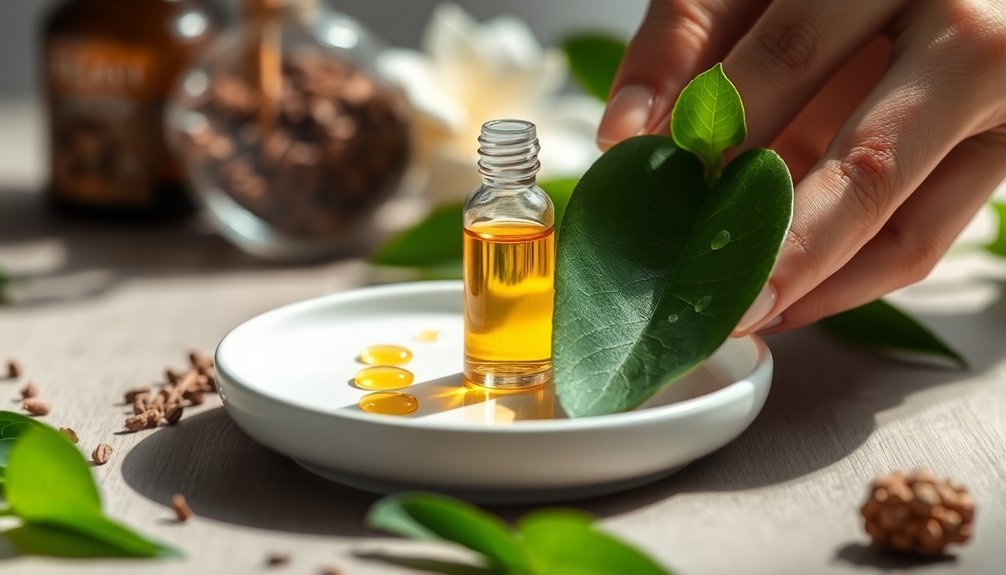
Since safety remains paramount in fragrance making, proper patch testing protocols help prevent adverse skin reactions and guarantee your creations are safe for use. You'll need to dilute your fragrance oils to 1-2% concentration in a carrier oil before applying them to your inner forearm. Don't disturb the test area for at least 48 hours to monitor both immediate and delayed reactions.
| Step | Action | Duration |
|---|---|---|
| 1 | Dilute oil to 1-2% | 5 minutes |
| 2 | Apply to forearm | 1 minute |
| 3 | Initial observation | 24 hours |
| 4 | Secondary check | 24 hours |
| 5 | Record results | 5 minutes |
Keep detailed records of your patch testing results, including the specific oils used, concentrations, and any reactions observed. This documentation will serve as a valuable reference for future formulations.
Blending Ratios and Documentation
Building upon safe testing practices, mastering proper blending ratios becomes your next key step in fragrance creation. Start with a 1:1 ratio when combining oils, but be ready to adjust based on each scent's unique characteristics.
You'll want to begin with small test batches of 2-5 mL to perfect your blend without wasting materials.
Keep detailed records of your blending process using these essential documentation steps:
- Record exact measurements of each oil used
- Note the specific fragrance combinations
- Track how the scent develops over time
- Document feedback from testing sessions
Maintain a consistent format in your fragrance journal or spreadsheet for easy reference.
This systematic approach helps you replicate successful blends and refine your blending ratios based on real results, leading to better fragrance outcomes.
Storage and Stability Testing
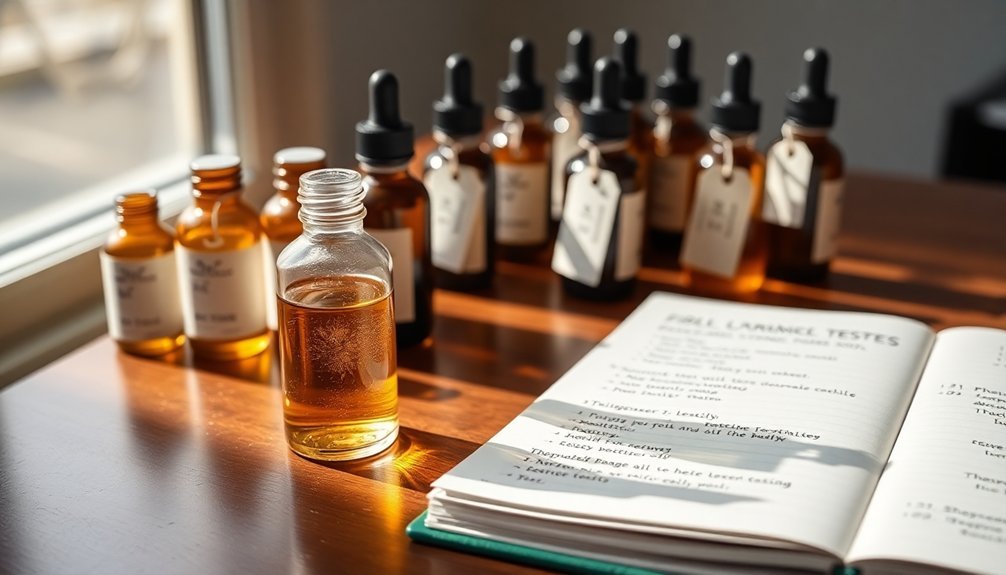
You'll want to store your fragrance oils at consistent temperatures between 65-75°F (18-24°C) to maintain their chemical stability and prevent premature degradation.
Testing your oils' shelf life requires placing small samples in different environmental conditions, including various temperature ranges and exposure levels, while monitoring changes in color, scent, and consistency over time.
Keep detailed notes of your stability tests, recording observations at regular intervals (weekly or monthly) to determine how long each oil maintains its intended properties.
Temperature Control Guidelines
Maintaining proper temperature control is essential for preserving the quality and integrity of your fragrance oils.
You'll want to implement strict temperature control guidelines to guarantee your oils remain stable during both storage and fragrance evaluation phases.
Keep these critical temperature monitoring steps in mind:
- Store your oils between 60-75°F (15-24°C) in a controlled environment
- Use amber or cobalt glass bottles to protect against UV degradation
- Monitor viscosity changes at different temperature points
- Document all temperature fluctuations and their effects
For accurate stability assessment, test your oils in various temperature conditions, from refrigeration to room temperature.
You'll need to regularly check for changes in consistency and scent profiles.
This systematic approach helps you identify potential issues early and adjust your storage practices accordingly.
Shelf Life Testing Methods
To guarantee your fragrance oils maintain their intended characteristics, implementing systematic shelf life testing methods is crucial for quality control.
You'll need to store multiple samples under controlled conditions, monitoring their performance at different temperatures and light exposures.
Track your samples' stability by evaluating both cold and hot throw at regular intervals – typically at one, three, and six months.
Watch for any physical changes like separation, cloudiness, or sediment formation, as these indicate potential degradation.
Keep detailed records of storage conditions and testing timeframes for each sample to accurately determine ideal shelf life.
Don't forget to conduct regular blind smell tests to detect subtle changes in the scent profile.
This thorough approach to shelf life testing guarantees your fragrances remain consistent and meet quality standards throughout their storage period.
Cross-Contamination Prevention
Preventing cross-contamination stands as a critical factor in achieving reliable fragrance testing results.
You'll need to maintain strict cleanliness protocols when handling different fragrance oils to guarantee your testing accuracy remains uncompromised.
To effectively prevent cross-contamination, follow these essential steps:
- Use separate, clean tools for each fragrance oil, including droppers, spatulas, and measuring cups.
- Store your oils in individual, sealed containers away from sunlight.
- Label all containers and tools immediately after use.
- Work in well-ventilated spaces to prevent scent overlap.
Remember to sanitize your workspace regularly with appropriate cleaning agents.
This practice eliminates residual scents that could affect your next evaluation.
Quality Control Checks and Verification
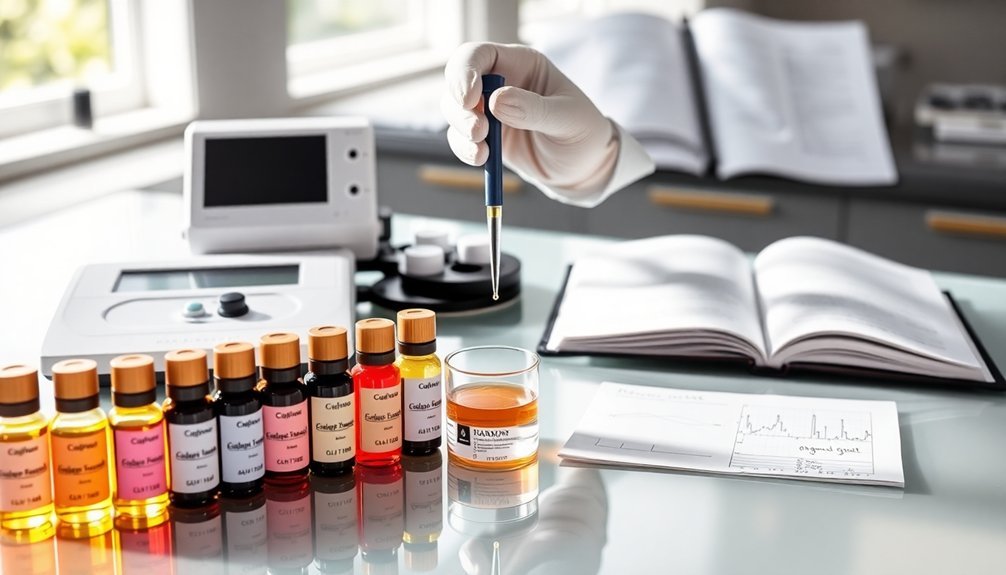
Quality control checks serve as the foundation for successful fragrance formulation, building upon your cross-contamination prevention practices.
You'll need to implement standardized testing protocols that cover all aspects of your fragrance oils, from wax compatibility to fragrance load performance.
Start by labeling each test sample with essential information like fragrance name, concentration, and testing date. Let your samples cure for 10-14 days before evaluating both cold and hot throw characteristics.
Keep detailed records in your testing journal to track performance patterns and identify any inconsistencies between batches.
Don't forget to engage trusted testers who can provide valuable feedback on scent performance.
Frequently Asked Questions
How to Test Fragrance Oils?
You'll want to use smelling strips dipped in oils, create small wax melt samples at 6-10% concentration, label everything clearly, test in different environments, and keep detailed notes during the curing period.
What Is the 30 50 20 Rule for Perfume?
You'll want to blend your perfume using 30% top notes for initial scent, 50% middle notes for the heart, and 20% base notes for lasting power. This ratio creates a well-balanced fragrance composition.
How Do You Know if a Fragrance Is Safe?
You'll need to check the Safety Data Sheet, verify IFRA compliance, review ingredients for allergens, perform a patch test, and read customer feedback. These steps guarantee you're using fragrances that are safe for intended use.
What Is the Best Way to Test a Fragrance?
You'll want to use smelling strips dipped in the fragrance, then create test wax melts at proper concentrations. Let them cure for 10-14 days before evaluating both cold and hot throw performance.
In Summary
You've learned the core safety practices for fragrance oil testing – from setting up a proper workspace to documenting your blends. By following these protocols for ventilation, protective equipment, patch testing, ratios, storage, contamination prevention, and quality control, you'll create fragrances safely and consistently. Remember: meticulous testing isn't just about achieving the perfect scent – it's about protecting yourself and your customers.
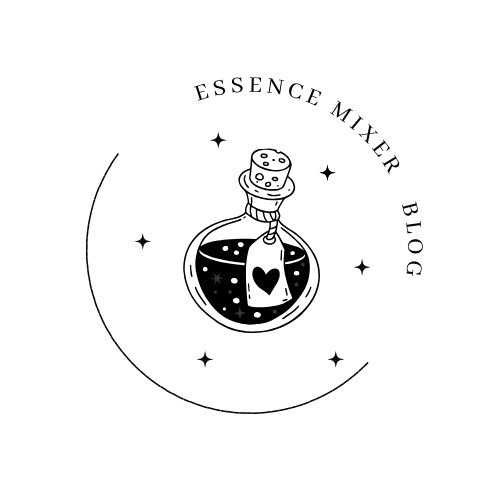
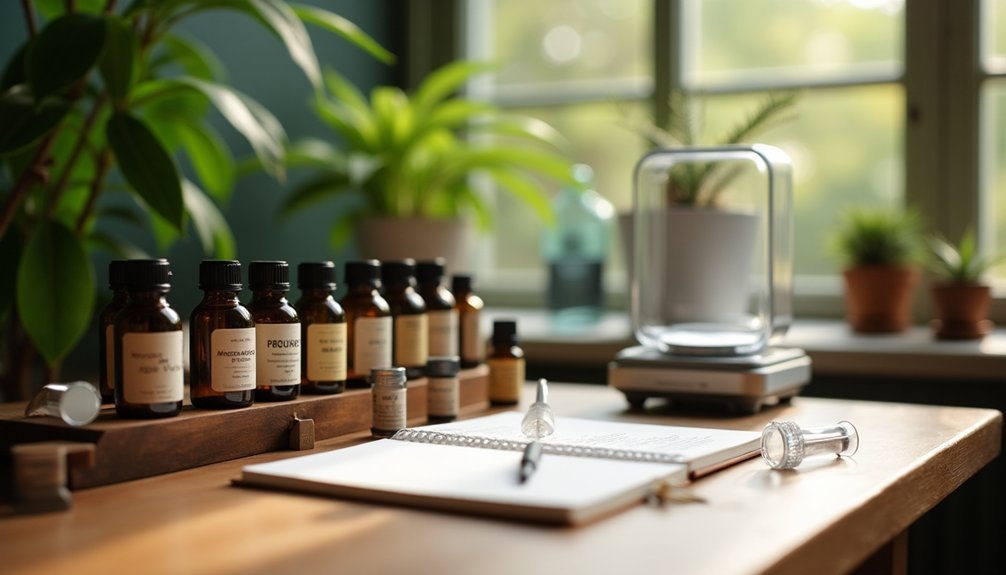



Leave a Reply